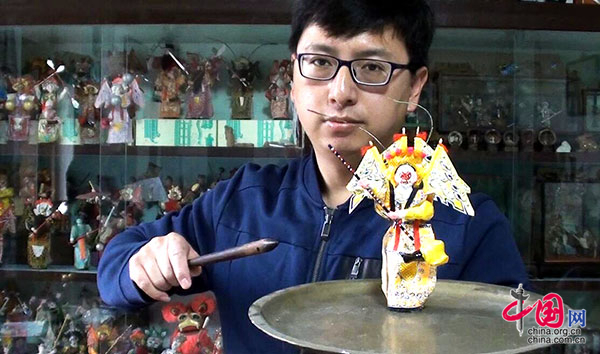Trumps' festive visit highlights ancient art of bristle dolls
- By Wu Jin and Yan Xiaoqing
 0 Comment(s)
0 Comment(s) Print
Print E-mail China.org.cn, February 20, 2017
E-mail China.org.cn, February 20, 2017
Using a wand-like stick to hit a bronze plate, Bai Lin made bristle dolls dancing and bouncing. The plate was used by native Beijingers to present cups of tea to visitors. The bristle dolls were all made by Bai Lin, heir to a century-long craftsmanship.
 |
|
Bristle doll inheritor Bai Lin plays the art. [Photo by Yan Xiaoqing / China.org.cn] |
"This is the game played by old Beijingners," Bai smiled. This is also the rendition he staged that mesmerized the daughter of Ivanka Trump when they visited the Chinese Embassy in Washington D.C. on Feb. 1, 2017, for the celebration of the Chinese Lunar New Year, which fell on Jan. 28, this year.
Having majored in English, Bai had no difficulties in introducing the art of bristle dolls to the foreign guests. The craftsmanship, which has almost become extinct in modern times, has once again aroused immense interest.
The handicraft has an intriguing history, during which, the rejuvenation of the art in modern times is much indebted to the efforts of Bai Dacheng, the predecessor and father of Bai Lin.
According to Bai Lin, his father, honored as the master of bristle craftsmanship, is the real hero behind the art, a spinoff of Peking Opera and Shadow Play.
In 1959, Bai Dacheng quit aviation school for health concerns. While staying at home, he came to know a craftsman engaged in making bristle dolls. Infatuated by the unique art form, Bai Dacheng embarked on an apprenticeship from which he learned, developed and revived the creation of the handmade figures during the vicissitudes of the past few decades.
"My father is the master of making bristle dolls. He has engaged in the craft for 40 to 50 years," Bai Lin said. "He has much of the art in his brain but he cannot teach."
Unlike his father, junior Bai, who was born in 1979, when China initiated the policies of reform and opening up, started a career as a cicerone travelling around the world and enjoyed the freedom of life on the move.
But in 2003, when the severe acute respiratory syndrome (SARS) swept China, Bai Lin quit his job and started to learn his father's craftsmanship.
"They are all in my childhood — the toys, bristle designs, stories and characters," Bai Lin recalled. Throughout the ensuing 14 years, the young man allowed his dedication to shift to no other field but the learning of doll making.
"I'm becoming aware of the responsibility of me to pass down the family skill that lasted for almost 120 years in four generations," Bai Lin said. "It's the modern generation responding to the culture and history of old fashions."
According to Bai Lin, there are 52 different processes in making bristle dolls, including bristle arrangement, facial painting and stitching. The exquisite handicraft of the doll usually takes one and half days to finish and are unsuitable for assembly line manufacturing, because the toy jerks at the vibration of bristles and the density and angles of those bristles decide the direction of movement.
"It needs patience and tranquility, and that it is why the handicraft can be called fine art," Bai Lin said.
Proficient in English and a master of the craft, Bai Lin has made lots of foreign friends become fascinated at the dolls. So the young man plans to teach the craft online.
"China's culture is both attractive and magnificent, but foreign people cannot understand it, so you need to introduce it to them."
But in addition to the growing interest of the foreign audience, the imminent issue that Bai Lin is most concerned about is how to pass down the traditional art to younger generations in the country. He brings the craftsmanship into the extracurricular courses in primary and middle schools as well as evolving the art by bringing in new characters such as the quintuple mascots of the Beijing Olympics Games into the designs.
"It is sad that we have lost lots of beautiful traditional arts," Bai Lin said. To counter people's misconceptions that traditional art is outdated, Bai calls for the respecting of history. He expects more and more children to join in his team to let the art of bristle dolls be passed down for generations to come.






Go to Forum >>0 Comment(s)